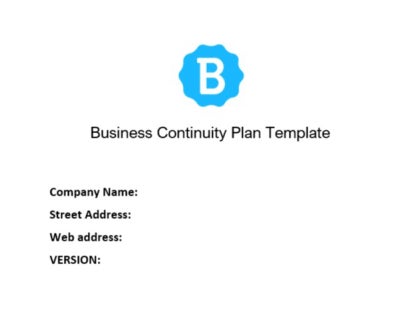The COVID-19 Pandemic:
The COVID-19 (Coronavirus) pandemic is a real-world example of an emergency situation in which a business continuity plan should be instituted.

Business Continuity Plan Template Download
Download this business continuity plan template in MS Word format and start using it straight away.
DownloadWhy is it Important To Have a Business Continuity Plan?
In times of crisis, having a business continuity plan in place will ensure your business is able to function, before, during, and after an emergency event.
A BCP will clearly outline the people and procedures involved in running your business when the worst happens. A Busines Continuity Plan is beneficial because:
- It is required by many business regulators, investors, and stakeholders.
- It provides a sense of security for managers and staff.
- It will allow your business to provide reasonable service to your customers during and after an emergency.
- It will allow you to preserve your revenue stream and your reputation.
- It can provide additional insight into your organization.
What Should Be Included In A Business Continuity Plan:
Business continuity plans are as varied and complex as businesses themselves. Every plan is different and should be based on the needs of your company and your customers. Here are a few general examples of what a BCP should include:
- The scope and purpose of your plan.
- Your plan's goals and objectives.
- A comprehensive list of tasks required to keep your operations going.
- The roles and responsibilities of your BCM team and your staff.
- The contact information for management and key BCM staff.
- Maintenance protocols for your plan.
- Information about site and data backups.
- Information on where to go in an emergency.
- Procedures to coordinate with emergency personnel.
How to Build a Business Continuity Plan:

A step-by-step guide to creating a business continuity plan.
Identify the scope of your plan.
Perform a regulatory review.

Before you create your business continuity plan, first consider the expectations and regularity standards that come from external stakeholders including investors, external partners, and auditors.
Identify the objectives of your plan.

When creating a comprehensive business continuity plan, a key step is to identify the objectives of your plan and then set goals accordingly. Here you should be considering how detailed your plan should be and which departments and staff members should be involved.
Define the outcome of your plan.

When creating the scope of your plan, you should also define the successful outcome of your plan and which milestones should be tracked during an emergency.
Form the business continuity management team.
Decide on the size of your team.

The business continuity management team is responsible for implementing and executing your BCP. The size of your team is dependent on the size of your company and the way in which you plan on rolling out your program.
Identify your key business areas and critical functions.
Complete a risk assessment.

The next step is to perform a detailed risk assessment on your company. A risk assessment allows you to understand the physical, financial, reputational, and operational risks to your company should a major disruption occur.
Have your team create a detailed list of threats and risks that would impact your business and rate them according to the likelihood of occurrence and severity. Examples of risks and exposures include:
- Natural disasters.
- Global pandemics.
- Staffing shortages.
- Cyber attacks.
- Single point disruptions.
- Strikes.
- Disruptions to the supply chain.
- Political instability.
Conduct a business impact analysis.

A business impact analysis will help you identify your business's core needs and determine the potential impact resulting from the disruption of business. Examples of impacts to consider include:
- Increase in customer dissatisfaction.
- Damage to company reputation.
- Loss of sales or income.
- Loss of equipment or data.
- Delay or loss of new business.
- Regulatory fines.
Identify your business processes and determine which would cause the most damage to the company if they were to fail. Classify each of these functions or processes as either:
- High
- Medium
- Low
Find out which business objectives they support, how often they occur, which departments they affect, and what other aspects of the business are dependent on these to function? Your BIA report should document the potential impact resulting from business disruptions and provide information that can be used in your recovery strategies.
Create an incident response plan.
Outline your operations plan.

This should be the most comprehensive section of your business continuity plan. You can break down operations activities into prevention strategies, response strategies, and recovery strategies.
Come up with prevention strategies.

In this section, you should detail any preventative measures that should be taken before a disruption occurs. This may include creating remote work solutions for your employees, having backup utility providers, alternative network resources, data backups, and server backups.
Detail response strategies.

Response strategies are needed when there is an emergency or sudden disruption of business. This section should detail what each member of your business continuity team should do in the event of an emergency. This includes evacuation procedures, safety protocols, and staff communications.
Plan your recovery strategies.

Recovery strategies ensure that critical business processes are restored after an emergency event or major disruption in business. Your plan should have a detailed description of the actions necessary to keep your business functional until all personal, systems, and facilities are operational again.
Develop a training curriculum.
Implement a training curriculum.

Once your business continuity plan is complete, it is important to implement a training curriculum for your business continuity management team and your company employees. Training should include a basic overview of your BCP as well as relevant and tactical exercises designed to test your continuity procedures.
It may be worth staging a mock emergency to establish the efficacy of your plan and highlight areas of improvement.
Conduct annual reviews.
Review and update your plan.

As your business grows and changes so should your business continuity plan. It is important to conduct annual reviews of your BCP to ensure that it aligns with your current processes and requirements. Updates should be made to evacuation procedures, staff contacts, and communication methods as needed.
Business Continuity Management Services:
For larger businesses, it may be worth employing the services of a business continuity consulting and management company, such as MHA Consulting, to review your BCP. These services may include:
- A comprehensive assessment of your current business continuity plan.
- Gap analysis.
- Recommendations and long-term planning.
- Annual updates.
- Training exercises.
Layoff Letter Due to COVID-19 (Coronavirus)


